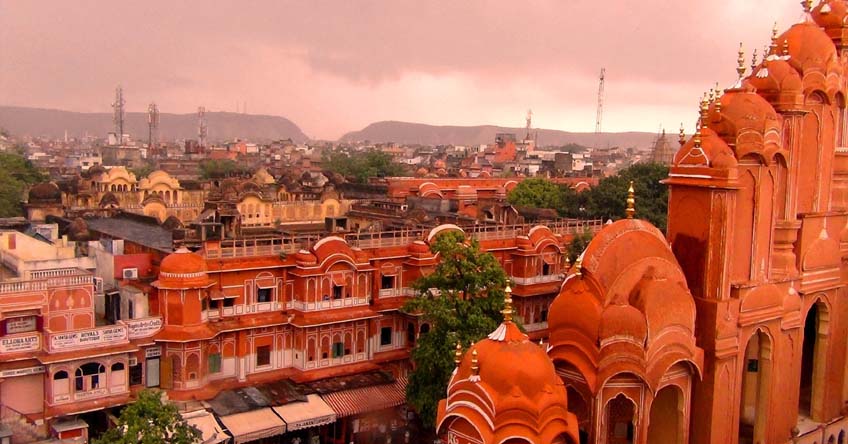About Jaipur

Jaipur, the colourful capital of a colourful state Rajasthan, renowned as Pink City, was founded in 1727 by Maharaja Jai Singh II and was formed following the principles of Shilpa Shastra of Indian Architecture.
It was painted all in pink to commemorate the visit of the Prince of Wales in 1876, since then most of its buildings are given a pink-orange wash. Jaipur is the only city in the world, which is sub-divided in to nine rectangular sectors symbolizing nine divisions of universe.
The major sights include the City Palace (Palace in Jaipur, built between 1728 and an illustration of a mix-up of Mughal and Indian architecture), Jantar Mantar, the astronomical observatory (The instruments like Ram Yantra in this observatory throw light on the status of Indian astronomy during the medieval period), Hawa Mahal, the Palace of the Winds, (five-storied building) which was built in 1799, with 953 windows or 'Jharokhas' which are decorated with intricate designs, wonderful state of the art temple, Birla Temple, which is made up of pure white marble must not be missed..
How to reach Jaipur
Jaipur, the capital of Rajasthan is one of the most visited tourist destinations in India. A large number of visitors have Jaipur as their first stop on a royal trip to Rajasthan. The Pink City has a lot to offer to the tourists. Also, reaching the place is not a very difficult task as the city has a major airport, a railway station and is well connected by road to different parts of the country.
By Air- Jaipur has an airport called Sanganer, 15 km from the city, which connects Jaipur to all major airports in India through direct flights. It has regular flights to Delhi, Kolkata, Mumbai, Ahmedabad, Jodhpur and Udaipur.
By Rail- Jaipur has a railway junction, which connects Jaipur with the metros and all the major cities of India. If you want to experience a truly royal ride, then you should take the train 'Palace on Wheels', which leaves from Delhi and connects a number of tourist attractions. If you prefer a more economical travel, then you can opt for the Pink City Express from Delhi. Other trains are the Shatabdi Express and the Intercity Express.
By Road-It is very convenient to travel to Jaipur by road. Regular government run buses and those by private operators’ are available for commuting to and from the city. The important highways connecting Jaipur to other important Indian cities are NH-8, NH-11 and NH-12.
Distance from major cities:
Jaipur - New Delhi 259 Kms
Jaipur - Mumbai 1202 Kms
Jaipur - Udaipur 405 Kms
Jaipur - Jodhpur 336 Kms
Jaipur - Jaisalmer 621 Kms
Jaipur - Ahmedabad 672 Kms
Jaipur - Kolkata 1510 Kms
SHOPPING:
The exclusive items include gems, Sanganeri cotton prints, kota sari, brassware and juti footwear. The main shopping centres are Rajasthali Govt handicrafts shop on MI Road and Chaupar stalls.
CLIMATE: Summer temp range, 25 to 45 deg C; winter temp range, 8 to 22 deg C
CLOTHING: Cotton in summer, light woollen in winter
LANGUAGES: Hindi, Rajasthani, English
Other city's attractions are – (Places to visit)
Old City - The old city is partially encircled by a crenellated wall - the major gates are Chand Pol, Ajmeri & Sanganeri. The mains bazaars of the old city i.e. Johri Bazar, Bapu bazaar, Tripolia Bazaar and Chand Pol Bazaar is worth to visit.
Govind Devji temple: The idol inside this Krishna temple was shifted here from Vrindavan in Mathura, in today's Uttar Pradesh, by Maharaja Sawai Jai Singh II. It is a well-known temple in the city.
Gaitore, one of the most prominent tourist attractions in Jaipur, is a royal cremation ground for the Kachhwaha Rajput kings and the members of the royal family.
Nahargarh Fort, along with other two forts viz., Amer Fort and Jaigarh Fort, once formed a strong defense for Jaipur city. Built by Maharaja Sawai Jai Singh II in 1734, this fort was originally named Sudarshangarh Fort. Later, it was given a new name, Nahargarh which means 'abode of tigers'. Located in one of the oldest mountain ranges of the world, the Aravalli Hills, this fort gives you a breathtaking view of the scenic surroundings.
Amber fort- Palace is located about 11km north of Jaipur. It used to be the capital of Jaipur state and it is a great example of Rajput architecture.
Jaigarh Fort - It was built by Sawai Jai Sigh for military purpose. This fort houses the largest cannon called "Jaiban"
Situated in the middle of a busy intersecting road of the pink city, Statue Circle is reminiscent of the rich history of Jaipur. It was built as a tribute to Maharaja Sawai Jai Singh II, the founder of the city. There are numbers of rich local delicacies and spicy snacks which are served by the vendors here. Besides being a famous tourist and picnic spot, the Statue Circle also serves as a favorite place for evening walkers, morning joggers, etc.
The Kanak Vrindavan Valley is an exotic place in Jaipur, and is located on the way to the Amer Fort.
Sisodia Rani Ka Bagh is situated at a distance of 10 km from Jaipur city and lies on Jaipur-Agra highway. This royal garden was built by Maharaja Sawai Jai Singh in 1728 for his second queen Sisodia. Sisodia Rani Garden is adorned with beautiful wall paintings of Radha-Krishna love story. The paintings on the wall and the narrative details truly represent eternal love and befits the essence of this garden which itself is a symbol of love.
Galta Ji : The temple of the Sun god at Galta, is 2.5km to the east of Jaipur, just beyond Surajpol Bazaar. There are good views over the surrounding plains and it's often packed with bathing pilgrims.